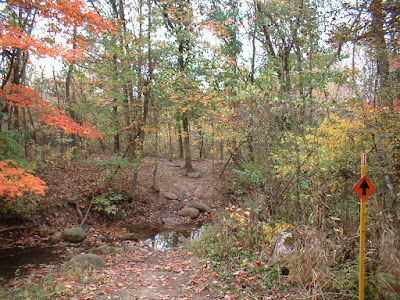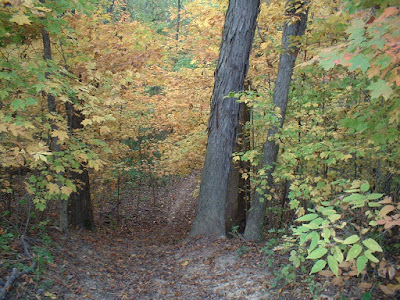Moving softly across the land means leaving no more than an echo. Whether you're afoot, astride a horse, on skis, or riding a mountain bike, the approach is the same. The medium changes but not the rules.
The foundation for all backcountry ethics is respect -- for land, for life, for one another, for yourself. It's that simple.
But while the concept is straightforward, consistently abiding by it is not. For example, I love finding new lines on the slickrock in Moab, Utah. The objective is to stay on the rock as much as possible, leave no skid marks, and never ride through delicate cryptogamic soil or vegetation. But in reality, leaving no trace is impossible. Lichen is crushed, sandstone crumbled, moss torn, and the rock scarred whenever a tire slips. Hiking has the same effect, even in running shoes.
The only way to leave no trace is to stay away. Consequently, the best I can do is minimize my impact. I choose routes precisely, always looking for aesthetically pleasing lines and paths that are defined by the contours of the land. When confronted with an especially steep face of rock with a slim chance of cleaning it, I look for another route rather than risk scarring it.
Sometimes these choices are blurred by the moment's action. For instance, if a 10-inch-wide band of cryptogamic soil lies between me and the fin of sandstone I want to reach-and there's no other route-do I continue riding or do I stop and walk? The latter means breaking my rhythm and losing momentum while the former involves scarring less than a square foot of soil, a pittance when measured against the desert's scale.
At first, the decision is obvious- keep riding. Except the cryptogam may be 30 years old and restoring it may take another 20. Are five decades of damage worth the fraction of a second it takes to ride across? Or, more bluntly, does my personal convenience override the cryptogam's need to survive? For if I ride, chances are good others will follow. Human tracks are like cancer cells; they multiply quickly.
To ride softly means to stop and step across. And mostly I do. But occasionally I'm so caught up in my riding that I lose sight of the turbulence I create. I hammer ahead, doing my best to ride cleanly, while rationalizing that I'll impact the land no matter how careful I am. I imagine this is true of most of us-hiker, biker, climber, horseman, etc.
More examples: Rain or melting snow turns a section of trail to mud. The easiest course is to ride through, churning it into a bog, instead of lifting the bike and walking past. Or a tree falls across a trail and rather than take the time to clear it or carry the bike over, we ride around and create a new path.
Or on a mountain pass, we spot an appealing viewpoint and casually ride across the tundra instead of leaving the bike and walking. Our tracks remain, soon someone else follows, and another trail begins.
Alone, these actions seem minor. But when multiplied by all of us in the backcountry, the effects can be major. More important, they're indicative of society's prevailing attitude that man's wants prevail. Consequently, the first step in moving softly over the land is recognizing that options exist - that we can choose to minimize and mitigate our impact.
Then there's the social dimension of soft cycling - the part that in terms of regulation and access is having tremendous influence on mountain bikers. Near Crested Butte, Colorado, is one of the finest singletracks I've ridden. I know it well and can trace its entirety in my mind. I know how fast its turns can be taken, where to shift and brake, and when to accelerate through blind corners. To blast over its length is a joy, except that should a hiker suddenly appear, one of us might get hurt.
Finding a hiker on this path is so rare that discounting the possibility is easy. And on an especially sparkling day, the trail almost begs to be toasted at maximum velocity. But soft cycling dictates that I do otherwise. Instead of blasting ahead, I hold back just enough to avoid such a collision. Just as I don't want to tear up the trail, I don't want to destroy another's enjoyment.
If one word defines soft cycling, it's responsibility. Under its rules, we are totally accountable for our actions. If we're injured or come across someone who is, we're equipped to deal with it. If a tire flats or a bike breaks, we have the necessary tools to fix it. What we carry in, we take out. What trash we find, we pick up. If a wind has blown deadfall across a trail, we clear what we can. Always, we have in mind that we're only visitors in the backcountry and so treat it accordingly. We respect our fellow visitors and their dreams, too, and treat each other with honor.
Ultimately soft cycling is a way of life, a way of thinking that stretches well beyond mountain biking. It's an awareness that the world and ourselves are constantly evolving, and that what we may arrogantly call "right" in our youth may be seen as humorous or destructive in our maturity. Who knows what mountain bikes will look like and be capable of in the future? Maybe those who fear our fat tires will be proven right, or maybe a new age of environmentalism will cite the mountain bike as our salvation.-Hank Barlow, Mountain Bike magazine
Rules of the Trail
These guidelines for trail behavior are recognized around the world. IMBA developed the "Rules of the Trail" to promote responsible and courteous conduct on shared-use trails. Keep in mind that conventions for yielding and passing may vary, depending on traffic conditions and the intended use of the trail.
1. Ride On Open Trails Only
Respect trail and road closures -- ask a land manager for clarification if you are uncertain about the status of a trail. Do not trespass on private land. Obtain permits or other authorization as may be required. Be aware that bicycles are not permitted in areas protected as state or federal Wilderness
2. Leave No Trace
Be sensitive to the dirt beneath you. Wet and muddy trails are more vulnerable to damage than dry ones. When the trail is soft, consider other riding options. This also means staying on existing trails and not creating new ones. Don't cut switchbacks. Be sure to pack out at least as much as you pack in.
3. Control Your Bicycle
Inattention for even a moment could put yourself and others at risk. Obey all bicycle speed regulations and recommendations, and ride within your limits.
4. Yield to Others
Do your utmost to let your fellow trail users know you're coming -- a friendly greeting or bell ring are good methods. Try to anticipate other trail users as you ride around corners. Bicyclists should yield to all other trail users, unless the trail is clearly signed for bike-only travel. Bicyclists traveling downhill should yield to ones headed uphill, unless the trail is clearly signed for one-way or downhill-only traffic. Strive to make each pass a safe and courteous one.
5. Never Scare Animals
Animals are easily startled by an unannounced approach, a sudden movement or a loud noise. Give animals enough room and time to adjust to you. When passing horses, use special care and follow directions from the horseback riders (ask if uncertain). Running cattle and disturbing wildlife are serious offenses.
6. Plan Ahead
Know your equipment, your ability and the area in which you are riding -- and prepare accordingly. Strive to be self-sufficient: keep your equipment in good repair and carry necessary supplies for changes in weather or other conditions. Always wear a helmet and appropriate safety gear.
















